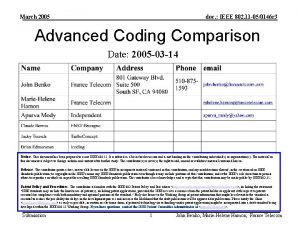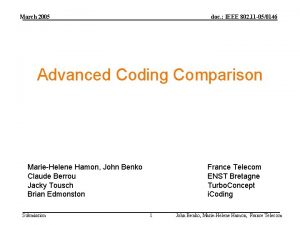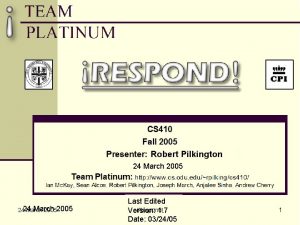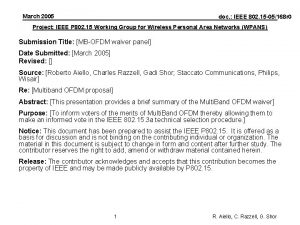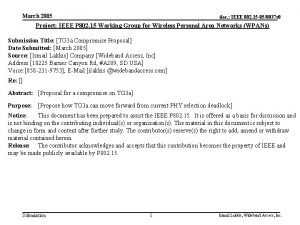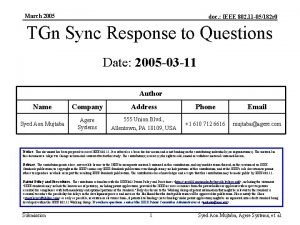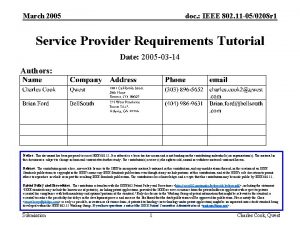March 2005 doc IEEE 802 11 050146 r










![March 2005 doc. : IEEE 802. 11 -05/0146 r 1 References • • [1] March 2005 doc. : IEEE 802. 11 -05/0146 r 1 References • • [1]](https://slidetodoc.com/presentation_image/03a7125e6577bbc2143ecdf9f645856a/image-11.jpg)
- Slides: 11

March 2005 doc. : IEEE 802. 11 -05/0146 r 1 Advanced Coding Comparison Marie-Helene Hamon, John Benko Claude Berrou Jacky Tousch Brian Edmonston Submission France Telecom ENST Bretagne Turbo. Concept i. Coding 1 John Benko, Marie-Helene Hamon, France Telecom

March 2005 doc. : IEEE 802. 11 -05/0146 r 1 Outline • • • Coding proposals in TGn Advanced FEC Code Requirements for TGn Comparing Codes LDPCC vs. Turbo Codes Facts & Recommendations Submission 2 John Benko, Marie-Helene Hamon, France Telecom

March 2005 doc. : IEEE 802. 11 -05/0146 r 1 Coding Proposals in TGn Partial (13): – – – – Nokia Infocomm Research ST Micro Nortel Panasonic Hughes Inprocomm Sharp Philips Trellisware France Telecom Motorola Wwise LDPC LDPC 7/8 CC Concatenated RS Hybrid LDPC/Turbo. Code Turbo Code TGn. Sync Wwise Mit. Mot Qualcomm LDPC Turbo Code None (Historical) Full: – – Submission Optional 3 John Benko, Marie-Helene Hamon, France Telecom

March 2005 doc. : IEEE 802. 11 -05/0146 r 1 Advanced FEC Code Requirements • Performance – – Much better than 802. 11 a CC Must have good performance for all blocksizes (small as well as large) • • • Small blocksize example: Vo. IP packets (as small as 50 bytes) Large blocksize example: Streaming HD-Video Latency – – • Low, < 6 us Good performance with a small number of iterations Implementation – – Submission Low Cost – small die size (memory and logic) Mature, 802. 11 – Chipsets require fast time to market Should not be held up due to a FEC without a well-defined implementation 4 John Benko, Marie-Helene Hamon, France Telecom

March 2005 doc. : IEEE 802. 11 -05/0146 r 1 Complexity Comparison Chip Area – Number of Gates – Technology used (ex. ASIC 0. 13 mm, average density of 222 kgates/mm 2) – Degree of Parallelism (relates also to max decoded bit-rate) Latency < 6 ms – Number of Iterations – Degree of Parallelism – Clock Frequency used (typical Fclk=200 MHz) Code Turbo Code* *Estimates from [4] +Estimates from [1] Max Encoded Block Size Fclk P Nit Total Memory Decoded Rate(Max) 2048 bits 200 8 5 59 kbits 320 Mbps 4. 8 ms 1. 4 mm 2 200 12 5 68 kbits 480 Mbps 3. 2 ms 2. 0 mm 2 200 12 8 68 kbits 200 Mbps 5. 12 ms 2. 0 mm 2 duo-binary MHz Max Area Latency (. 13 mm) Wwise LDPC+ 1944 bits 240 ? 12 ? 300 Mbps 6. 0 ms ? Sync LDPC 1728 bits ? ? Submission 5 John Benko, Marie-Helene Hamon, France Telecom

March 2005 doc. : IEEE 802. 11 -05/0146 r 1 ST-Micro (Wwise)* LDPCC vs. TC • SISO AWGN • BPSK+ • N=1744 bits • Wwise LDPCC -972 bits (121. 5 bytes) 12 i => 600 k. Gates, 6 us • Duo-Binary TC -976 bits (122 bytes) 8 i, P=12 => 2. 0 mm 2, 5. 12 us • TGn. Sync LDPCC -Equivalent not found *Wwise Results from Berlin presentation [1] +BPSK, R=1/2 proposed as optional mode in Wwise Submission 6 John Benko, Marie-Helene Hamon, France Telecom

March 2005 doc. : IEEE 802. 11 -05/0146 r 1 Wwise LDPCC*, TC and CC 2 x 2 SDM, AWGN 64 -QAM, R=3/4 Gains over CC @ 10 -2 PER • TC : ~3. 2 d. B (8 iterations) • LDPCC: ~2. 4 d. B (12 iterations) TC LDPCC CC *Wwise Results taken from [2] Submission 7 John Benko, Marie-Helene Hamon, France Telecom

March 2005 doc. : IEEE 802. 11 -05/0146 r 1 LDPCC from. 16 e* SISO, AWGN, QPSK, R=1/2 LDPCC - 50 iterations (unrealistic) TC - 8 iterations (realistic) TC Gains over LDPCC@ 10 -2 PER • N=2304: 0. 2 d. B TC LDPCC • N=576 : 0. 3 d. B TC LDPCC (increase with smaller block size) *LDPCC here [3] is slightly different from what is used in TGn. Sync Submission 8 John Benko, Marie-Helene Hamon, France Telecom

March 2005 doc. : IEEE 802. 11 -05/0146 r 1 LDPCCs vs. Turbo Codes (TCs) LDPCCs TCs History Discovered in 60’s by Gallager -Implemented only in past few years -Original Patent expired, but -Since March 2001, 152 Patents have been applied for/ granted concerning LDPCCs [5] Discovered in early 90’s by Berrou, et al. -Patents exist, but -Well defined licensing program Technology New Development -Hot Research Topic at many universities -No common implementation available Mature, Stable -Well established & implemented -Ongoing Research at select universities - Turbo Decoders are already available Performance* (Implementation targeted for ASIC, but also FPGA) Improves as the block size increases Good performance for all. 11 n block sizes (given latency requirements) *Generalization Submission 9 John Benko, Marie-Helene Hamon, France Telecom

March 2005 doc. : IEEE 802. 11 -05/0146 r 1 Facts & Recommendations • Modularity – – • Performance of the FEC code is independant of system Codes proposed can be easily put in WWise and TGn. Sync Difficult to compare – – From FRCC, code performance seen only in context of full system Current two proposed specfications differ • – – • Wwise nor TGn. Sych provided simulation results for their code with other proposal Codes compared in performance should be of similar complexity Very little complexity results have been seen to this date Mature code – • Enables pre and 1 st production devices to ship with advanced coding options. Action Item? – – Submission We need to re-think(create) the advanced coding selection process or we might get stuck with an advanced coding scheme that is not in the best interest of the 802. 11 n Suggestion: Form a separate coding sub-group 10 John Benko, Marie-Helene Hamon, France Telecom
![March 2005 doc IEEE 802 11 050146 r 1 References 1 March 2005 doc. : IEEE 802. 11 -05/0146 r 1 References • • [1]](https://slidetodoc.com/presentation_image/03a7125e6577bbc2143ecdf9f645856a/image-11.jpg)
March 2005 doc. : IEEE 802. 11 -05/0146 r 1 References • • [1] IEEE 802. 11 -04/400 r 4, " ST Microelectronics LDPCC Partial Proposal for 802. 11 n CFP”, ST Micro, September 2004. [2] IEEE 802. 11/04 -0877 -09 -000 n, “WWi. SE proposal response to functional requirements and comparison criteria. ” [3] IEEE 802. 16 e-0/006, " LDPC Coding for OFDMA PHY", January 2005. [4] IEEE 802. 11 -04/1382 r 1, "Turbo Codes: Complexity Estimates", Turbo. Concept France Telecom R&D, November 2004. [5] http: //www. uspto. gov [6] C. Berrou, A. Glavieux, P. Thitimajshima, "Near Shannon limit errorcorrecting coding and decoding: Turbo Codes", ICC 93, vol. 2, pp. 1064 -1070, May 93. [7] C. Berrou, "The ten-year-old turbo codes are entering into service", IEEE Communications Magazine, vol. 41, pp. 110 -116, August 03. [8] C. Berrou, M. Jezequel, C. Douillard, S. Kerouedan, "The advantages of non-binary turbo codes", Proc IEEE ITW 2001, pp. 61 -63, Sept. 01. Submission 11 John Benko, Marie-Helene Hamon, France Telecom












